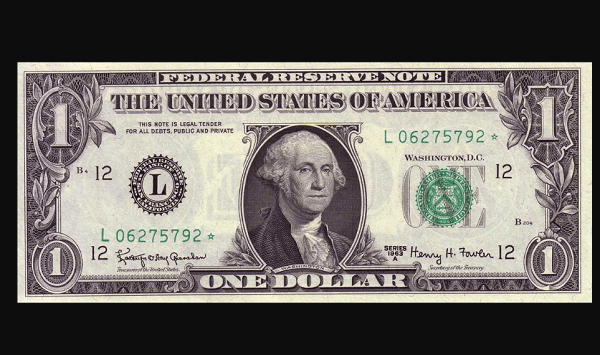1963 1 Dollar Bill Value – The 1963 1 dollar bill is a popular piece of currency among collectors and history enthusiasts. With its iconic design featuring President George Washington, this bill holds significant value in both monetary and historical terms.
However, what makes the 1963 1 dollar bill even more intriguing are the various misprints and errors that can be found on certain bills.
The 1963 one dollar bill is not considered a rare or valuable bill. In fact, most of these bills will only be worth their face value of $1. However, that doesn’t mean there aren’t any interesting aspects to these bills. One variation that can increase their value is the B series.
These distinctive $1 Federal Reserve Notes bear the signature of Joseph W. Barr, who served as Secretary of the Treasury during the last 28 days of President Lyndon B. Johnson’s administration.

In this blog post, we will delve into the world of the 1963 one dollar bill and explore its value, misprints, and errors.
1963 1 Dollar Bill Specifications
The 1963 one dollar bill holds a special place in the hearts of collectors and history enthusiasts. May not be considered a rare or valuable bill, but it still has its own unique specifications that make it interesting.
Denominated at $1.00 USD, this bill is classified as a Federal Reserve Note. The seal on the bill comes in one variety, which is green in color. What sets the 1963 one dollar bill apart is its series.
There are three series for this bill, namely 1963, 1963A, and 1963B.
These different series add a touch of diversity to the bills, allowing collectors to have a wide range of options to choose from.
1963 One Dollar Bill Value
When it comes to the value of the 1963 one dollar bill, most bills in circulated condition will only be worth their face value of $1. However, if you happen to come across a bill that is in uncirculated condition, you may be able to sell it for a premium.
This is because collectors are willing to pay more for bills that are in pristine condition.

Specifically, the 1963 series $1 bills in uncirculated condition with an MS 63 grade are worth around $6.50. The 1963A series $1 bills in the same condition and grade are worth around $5.50.
As for the 1963B series $1 bills, they are worth around $2.00 in very fine condition and around $6 in uncirculated condition with an MS 63 grade.
So, keep an eye out for any unusual features or mistakes on your 1963 $1 bill, as they could add to its value.
1963 One Dollar Bill Star Notes
Star notes are a fascinating aspect of the 1963 one dollar bill that collectors and enthusiasts should take note of. You can easily identify a star note by looking for a star symbol at the end of the serial number on the bill.
Most 1963 series $1 star notes are worth around $4-6 in very fine condition. If you happen to come across an uncirculated star note with an MS 63 grade, you could potentially sell it for around $10-12.
For the 1963A series $1 star notes, they are worth around $4 in very fine condition. In uncirculated condition with an MS 63 grade, the price is around $10-12.
The 1963B series $1 star notes have a higher value compared to the previous series. In very fine condition, these star notes are worth around $5.50.
If you come across an uncirculated note with an MS 63 grade, you could potentially sell it for a higher price range of around $14.50-20.
Keep an eye out for these special star notes, as they can add value to your collection.
1963 One Dollar Bill Grading System
To grade the 1963 one dollar bill, there are two main categories to consider: very fine and MS 63 choice uncirculated.
A note that falls under the very fine category has been in circulation but not for a long time. It still maintains its relatively crisp appearance, although there may be some creases, folds, or light smudges present.
On the other hand, an MS 63 choice uncirculated note shows no signs of ever having been in circulation. It retains its original crispness and is well-centered on the bill.
Grading plays a significant role in determining the value of the 1963 $1 bill.
An uncirculated note with an MS 63 grade can sell for a higher price compared to one in very fine condition. Collectors are willing to pay more for bills that are in pristine condition and have been well-preserved over time.
Common Misprints and Errors on the 1963 One Dollar Bill
The 1963 one dollar bill, like any other piece of currency, is not immune to misprints and errors. These mistakes can occur during the printing process and can add value and intrigue to certain bills.
One common misprint on the 1963 $1 bill is the inverted reverse design, where the back of the bill is printed upside down in relation to the front.
This error can make a bill more valuable to collectors who appreciate the uniqueness of such mistakes.
Another notable error on the 1963 $1 bill is the missing seal or serial number. This occurs when the printing process skips these elements, resulting in a blank space where they should be.
These bills with missing elements can be highly sought after by collectors due to their rarity.
Other minor printing errors, such as misaligned prints or blurred ink, can also increase the value of a 1963 $1 bill.
Note that the value of a misprinted or error-ridden 1963 $1 bill can vary greatly depending on the severity and rarity of the error.
What is special about a 1963 B dollar bill?
What sets the 1963 B dollar bill apart from other bills of the same series is its unique connection to history.
These distinctive $1 Federal Reserve Notes bear the signature of Joseph W. Barr, who served as Secretary of the Treasury during the last 28 days of President Lyndon B. Johnson’s administration.
The presence of Barr’s signature on these bills adds a special historical significance that collectors and enthusiasts find intriguing.
The 1963 B dollar bill may not have a high value in terms of monetary worth, its connection to a specific moment in history makes it a fascinating piece of currency to own. It serves as a tangible reminder of a short but significant period in American politics and economics.
How much is a 1963 B Barr note worth?
To determine the value of a 1963 B Barr note, it’s important to consider a few factors. The 1963 B series $1 bill is not considered a rare or valuable bill, so most of these notes will only be worth their face value of $1.
However, in the market, you may find listings for a 1963B BARR NOTE priced at around $2.49 for a note in “Good or Better” condition.
Collectors often seek out bills that are in uncirculated condition and have been well-preserved over time, as these notes tend to command higher prices.
The 1963 B Barr note may not be the most valuable or rare bill, but its historical significance adds to its collectible appeal.
Conclusion
With the investment and collectible appeal of the 1963 1 dollar bill, it’s important to have realistic expectations. While most of these bills will not be worth much more than their face value, there are certain factors that can increase their value.
For example, bills in uncirculated condition and those with a higher grading grade, such as MS 63, tend to sell for a premium.
Star notes, which are replacement bills printed by the United States Federal Reserve, are rare and thus more valuable. These star notes can fetch a higher price in the market.
The value of a 1963 $1 bill depends on factors such as its condition, grading, and any unique features or errors it may have. Collectors and enthusiasts should carefully evaluate these characteristics to determine the true worth of a bill.